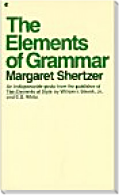

| Book of the Month | ||
 |
The Elements of Grammar |  |
Publisher: Collier Books
Author: Margaret Shertzer
$11.95
ISBN 0-02-015440-2
This book is one of a set of two. The other book in the set (which will be reviewed in March) is Elements of Style. However, while it is useful to have a good style when speaking or writing English, it is essential to have good grammar. As the author says in the first chapter 'Few people wish to appear illiterate'. This statement is proven correct by the fact that this book has been re-published a number of times, and even some professional writers admit that they own the book to use as a handy reference. For the student of English as a second language this book has the advantage that it starts at the beginning. That is, it begins by defining nouns, adjectives, adverbs and other parts of grammar. The disadvantage is that it was written for native speakers and sometimes uses explanations that are harder to understand than the English being explained. The book is also intended for users of American English, so expect 'periods' instead of 'full stops' and US spelling throughout.
This is a short book - 168 pages in all, including the index. There are no illustrations, but the text is well spaced. This is partly because the author uses numerous examples to illustrate each point, so the grammatical explanations are usually short and to the point. In fact they are not so much explanations as rules - 'This point of grammar is used in this way - for example, here and here'. This is rather like being lectured by an old-fashioned schoolteacher, and some readers will find the style unpleasant, especially if, like this reviewer, they do not always agree with some of the author's 'rules'. (For example the author says that it is acceptable to write "the 1900's" for that century even though there is no reason for the use of the apostrophe before 's', and says there is 'no such spelling' as 'alright' though several dictionaries disagree).
The book has seven chapters, though the first chapter 'Recognizing Good Grammar' is more of an introduction. The grammatical part begins with chapter two which describes types of word and the parts of a sentence. (The parts of a paragraph are more elements of style). The next forty pages are given to 'Points of Grammar' and quickly cover the ground from pronouns to subordinate clauses. Capitalization is considered so important that it gets a chapter of its own. This is a rather good chapter, but it means that the rest of punctuation, from commas to italics and over a dozen other items between are all jammed into the next chapter, putting the book out of balance. The same lack of balance is seen in chapter eight, 'Signs and Symbols' where the symbol 'x' is described in detail, even though the symbol for multiplication is well-known, but the symbol for a grave accent is simply described as a 'grave accent' (it is actually used to mark where the stress is on some non-English words.) The book finishes with a well-constructed appendix which greatly increases its usability as a handy reference book.
Who is this book for? This book is not useful for a student learning grammar for the first time. Rather it is intended to be used by someone who knows English better than English grammar, and who needs to be told when and why to use (for example) an object rather than a subject pronoun. As the author has noticed,the same person probably needs to be told what object and subject pronouns actually are. So the ideal user of this book is someone who already knows English but needs a handy reference guide for those times when correct English is important - for example when preparing a CV (or résumé as the US author would say - though without explaining in chapter eight the meaning and use of the acute accent over the 'e').
Verdict: A usable but below-average grammar guide
Assessment 3/10